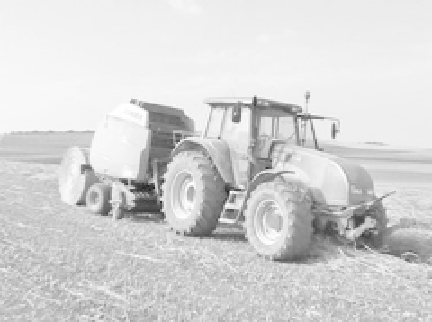Agriculture Reference
In-Depth Information
10
9.5
9
8.5
8
7.5
7
6.5
6
5.5
5
F12
F17
F19
F32
Variety
F34
E68
F77
D88
Fig. 6.13.
Hurd yield for French varieties
according to their precocity. (ITC summary, 2004).
Fig. 6.12.
Pressing the hurds with a round baler in
the Aube (ITC ©).
early varieties. The latest varieties are almost
all dioecious, but this does not allow us to con-
clude that hurd yield is lower for dioecious
varieties than for monoecious varieties, as male
plants are much lighter than female plants.
In areas of eastern France where the poten-
tial is poor, the hurd yield is generally situated
between 4 and 7 t/ha. In areas more favoured
by nature (deep soil with good water reserves),
the yield varies between 8 and 13 t/ha, whereas
wheat yields vary between 8 and 11 t/ha.
The hurd yield for dioecious varieties used
to produce fibre for the thread industry falls
between 13 and 15 t/ha.
in seed yield where sowing density is low (as is
the case where seed is sown in lines).
The commonest yield-limiting factor is
water availability, which particularly disadvan-
tages small stony fields. There are no refer-
ences on the subject of hemp irrigation. The
critical period for hurd yield is the rapid growth
phase between the end of May and the end of
July. The hemp seed yield is affected by cli-
matic conditions at the end of the vegetative
period. Any significant stress at this time can
shorten the flowering time and therefore the
yield in hemp seeds.
The hemp seed yield for early French vari-
eties cultivated in France and Germany is very
regular, between 900 and 1100 kg/ha, and no
marked distinction can be made between shal-
low and deep soil. The yield is noticeably higher
by 150-250 kg/ha for USO31, which is ear-
lier by 10 or so days. The yield in hemp seed
increases with advancing maturity, attaining its
optimum when approximately 80-90% of the
seeds have taken on a brown colour. At this
stage, the risk of shelling must be taken into
consideration and, in most cases, it is not worth
waiting to harvest, as losses will exceed any
benefit.
Hurd yield is much more variable
(Fig. 6.13). The duration of the growth phase
plays a role in the development of the yield.
Thus, where an early variety is sown (under
good conditions), hurd production will be
favoured. Late varieties exhibit a longer growth
phase and, in this respect, perform better than
6.2.5 Retting
According to the dictionary definition, retting
is an operation that facilitates the separation of
textile fibres by destroying the material that
binds these fibres together. This can be done
through macerating in water, exposing to dew
or to humid heat.
Whereas retting in water is still practised
and used in the Danube valley and in China for
the production of textile fibres, it has been
abandoned completely by producers in Western
Europe.
Field retting is recommended by the major-
ity of fibre extraction workshops. Producers
will, however, prefer to take advantage of
favourable weather conditions and bring in dry
hurds; retting therefore occurs as a result of
climatic circumstance rather than through a
deliberate act. A significant financial incentive
would be needed to advance this practice.













